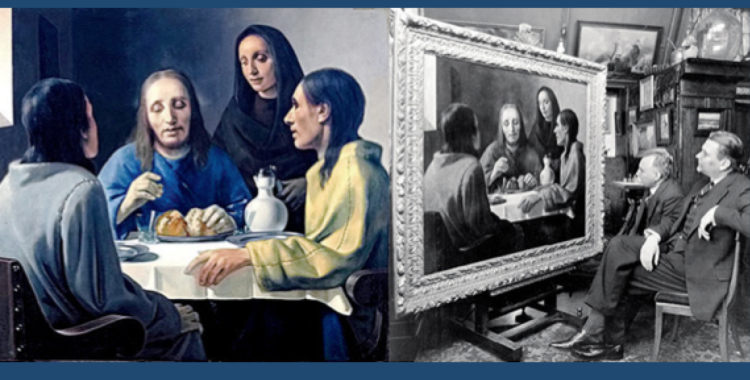
F is For Fake
March 11, 2015
by Diana Greenwald | Filed in: Interdisciplinary
In his famous essay The Work of Art in the Age of Mechanical Reproduction (1936), Walter Benjamin wrote: “In principle, the work of art has always been reproducible… Replicas were made by pupils in practicing for their craft, by masters in disseminating their works, and… by third parties in pursuit of profit…[However], in even the most perfect reproduction, one thing is lacking: the here and now of the work of art—its unique existence in a particular place.” This statement—that the unique original work of art is inherently more valuable than the copy—creates an interesting avenue of research for a scholar interested in the economics of art. While critics like Benjamin and philosopher Arthur Danto agree that the intrinsic value of the original work cannot be reproduced, can economists and art historians reach the same conclusion?
Forgeries have been the center of several museum exhibitions and academic research projects. Right now, London’s Dulwich Picture Gallery is exhibiting a £120 replica of a painting in its collection. The gallery is inviting both the public and experts to attempt to spot the fake in its new exhibition Made in China: A Doug Fishbone Project. This is not the first time a museum has attempted to address the issue of forgery with an exhibition. London’s National Gallery exhibited Close Examination: Fakes, Mistakes & Discoveries in 2010. However, for museum curators—people dedicated to preserving the unique and priceless—to openly explore and perhaps question the value of original works perhaps runs counter to their own professional missions. Therefore, it has been more common for art historians working in the context of a university rather than a museum to study art that could be considered unoriginal.
University of California, Berkeley emeritus art historian Svetlana Alpers’ book Rembrandt’s Enterprise: The Studio and the Market (1988) was one of the first studies to challenge concepts of originality and value. Alpers argued that the collective work of studio and the training of artists able to invoke and imitate his style were essential to his artistic project. Other scholars who have since engaged with these questions in art historical contexts are James Ackerman and Elizabeth Cropper. Continuing to study and further the understanding the value of copies and copying, current UC Berkeley Assistant Professor Winnie Wong researches the intersection of forgeries and “readymades” in contemporary China.
While these exhibitions and studies treat what philosophers and art critics may consider being copies as works of art worthy of study, they do not address a core question about copies, forgeries, and reproductions: how can one assess their value? If a forgery is perfect—same appearance, same materials—should it not be worth the same amount as the original? While aesthetic philosophers have already tackled this question in general, and art historians have explored specific case studies, researchers working at the intersection of studies of art and economics may be able to provide novel answers.
<< The Arts in Science and Nature
